Why You Should Optimize Gmail
New users, especially those coming from outdated email services, sometimes marvel at advanced Gmail features, such as the free storage space they get from Google.
Indeed, 15 GB seems like a lot considering that the average text-only email is less than 100 KB large, but there’s one critically important catch: the storage space is shared across Gmail, Google Drive, and Google Photos.
When your account reaches its storage limit, you lose the ability to send or receive new emails.
In other words, you don’t actually have nearly as much storage space for your emails as it may seem at first. That’s why you should proactively organize your email and adjust Gmail inbox settings to prevent unimportant and old emails from taking up valuable storage space, and the Clean Email app makes the organization straightforward.
Step 1: Optimize Gmail Inbox by Unsubscribing from Annoying Email Senders
Unwanted email subscriptions are among the biggest storage space thieves out there, which is why you should tackle them first when you embark on your email organization journey.
In most cases, unsubscribing from unwanted subscriptions is relatively easy: you open a subscription email, click an unsubscribe link next to the sender's name, and confirm your decision to unsubscribe.
Sometimes, however, marketers hide unsubscribe links (which they must include by law) to make it harder for subscribers to click them, and some don’t include them at all. There’s also the fact that unsubscribing from a large number of subscriptions at a time can be time-consuming and tiring if you use the manual approach.
Fortunately, there's a powerful alternative named Unsubscriber, one of the best Gmail hacks for productivity. This useful feature of the Clean Email app lets you unsubscribe from all the annoying subscriptions regardless of whether they contain unsubscribe links or not with a simple click. To use it:
- Go to https://app.clean.email/
- Sign in with your account.
- Select the Unsubscriber tool from the left panel.
- Click the Unsubscribe button next to each subscription you no longer want to receive (you can select multiple subscriptions and unsubscribe from all of them together).

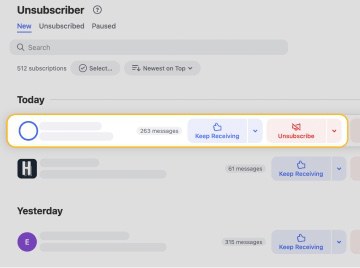
Besides unsubscribing, the Unsubscriber feature offers other Gmail tricks and tips, letting you pause subscriptions, move them to the Read Later folder, and more to give you plenty of ways to a clean email inbox.
Step 2: Use Smart Cleaning Suggestions to Optimize Gmail Inbox
Sometimes, it’s easy to identify emails that shouldn’t be in your inbox (unwanted subscriptions are a good example). The tricky part comes when trying to decide which other emails to delete after you've handled the obvious ones, and that can take up a lot of time.
The solution is Clean Email's Cleaning Suggestions feature. Designed to make your inbox management more efficient, Cleaning Suggestions make it easier to clean up Gmail storage.
The feature analyzes frequently organized messages based on attributes such as sender addresses, subject lines, number and size of attachments, and message age. It can make suggestions based on similar messages that you've previously cleaned or those often cleaned by other app users.
To see Cleaning Suggestions:
- Go to: https://app.clean.email/
- Sign in with your account.
- Select the Suggestions option from the left pane.
- Easily accept or dismiss the suggestion based on your preference.
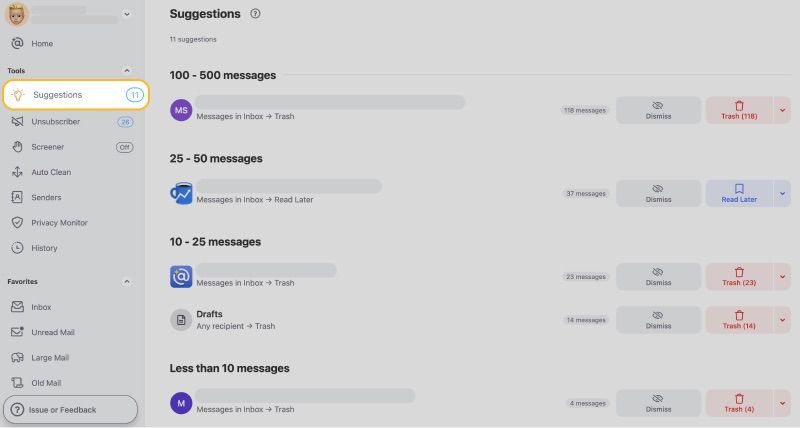
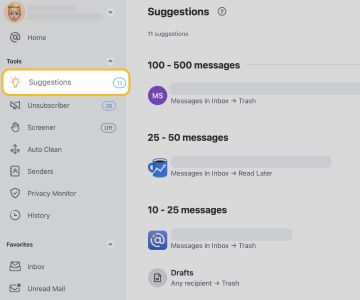
Each suggestion details the criteria and action, enabling quick cleaning. You can preview the messages in a group to understand their relevance.
💡 Note: Clean Email adheres to a strict privacy policy. Individual messages are never analyzed by staff or shared with other users, and suggestions are created using anonymous statistical data.
Cleaning Suggestions doesn't just help you identify which emails to delete but also provides shortcuts to clean these messages quickly and easily. Whether moving messages to Read Later or Trashing them, you have control over the process and the actions you take on your emails.
Step 3: Optimize Gmail Inbox Automatically with Auto Clean
As useful and convenient as Cleaning Suggestions are, they still leave something to be desired, and that something is the complete automatization of Gmail organization.
What if you could automatically move emails to a folder as soon as they arrive, effortlessly configure Gmail auto archive rules, or take advantage of the automated email tasks? Well, your inbox would be a lot more organized, and you would have more time for important tasks.
The good news is that Clean Email’s Auto Clean feature empowers you to create sophisticated inbox automation rules in a few simple steps, allowing you to move, label, archive, and perform other actions without any manual work required.
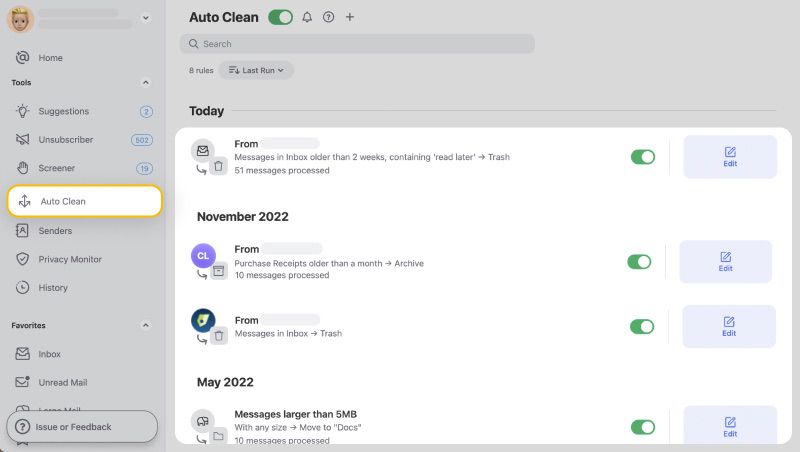

Bonus Gmail Optimization Tips
Are you hungry for more tips on how to optimize Gmail storage? Then keep on reading because this section contains three bonus Gmail productivity tips for enhanced optimization.
Tip 1: Block Unwanted Senders
Are there some senders who are constantly bothering you and sending you messages you don’t care about? Then don’t hesitate to block emails from unwelcome senders.
How? By automatically moving all emails from them to the Trash folder using Clean Email.
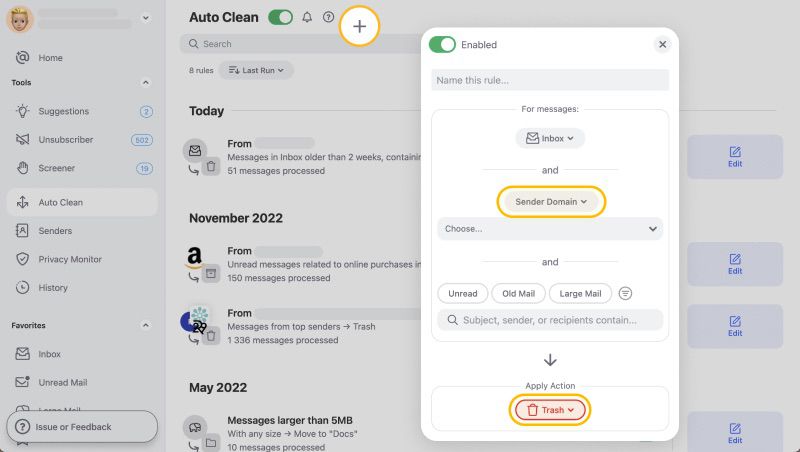

Alternatively, you can flag their emails as spam, and Gmail should eventually start moving new messages from the same senders to the Spam folder.
When you block an unwelcome sender using Clean Email or by flagging their messages as spam, the sender won’t be notified that their messages can’t reach you anymore, so you might want to politely let them know yourself.
💡 Note: Moving messages to the Trash does not immediately delete them permanently. They will remain in the Trash folder for 30 days before being automatically deleted. If you wish to delete them sooner, you can manually clean the Trash folder or choose the Delete action in Clean Email (to immediately remove emails) instead of moving messages to Trash.
Tip 2: Snooze Emails if You Can’t Respond Right Away
Gmail has a useful Snooze feature that lets you temporarily remove messages you don’t have time to deal with right now until a specified time in the future, such as later the same day or tomorrow.
To snooze a message:
- Log in to your Gmail account.
- Right-click (Control-click on a Mac) the message you want to snooze.
- Click the Snooze option and specify when you want to receive the message.
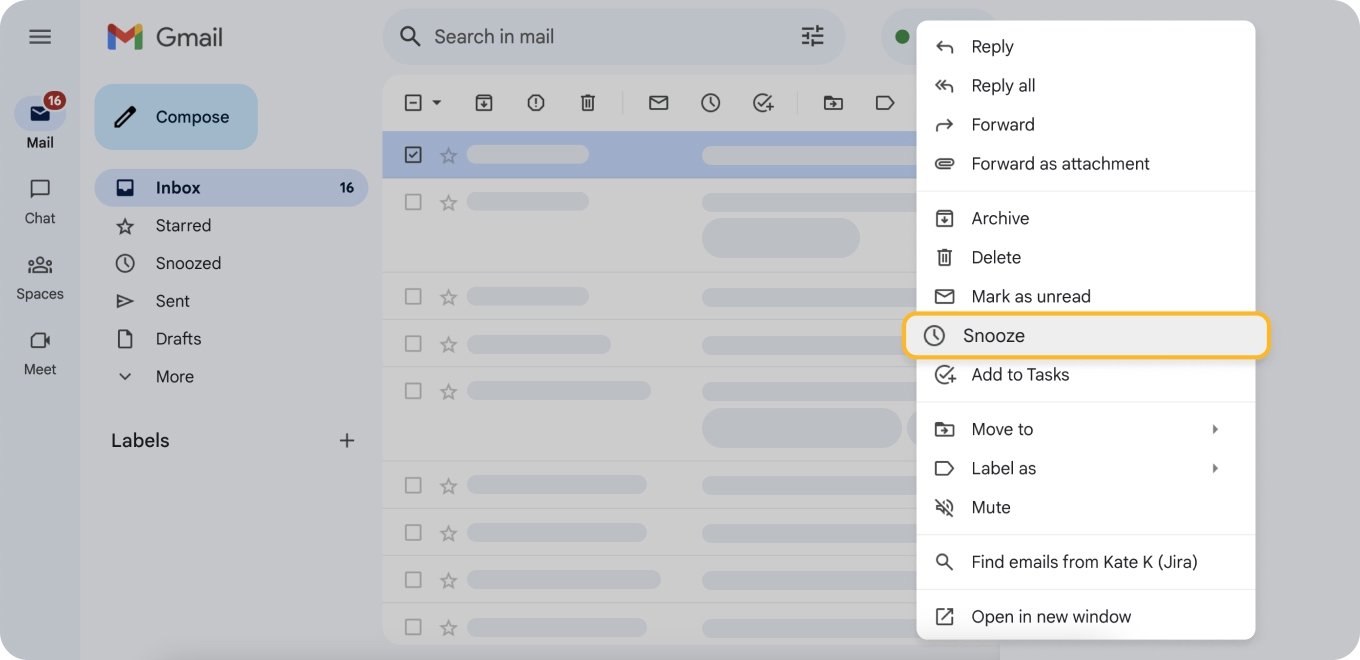
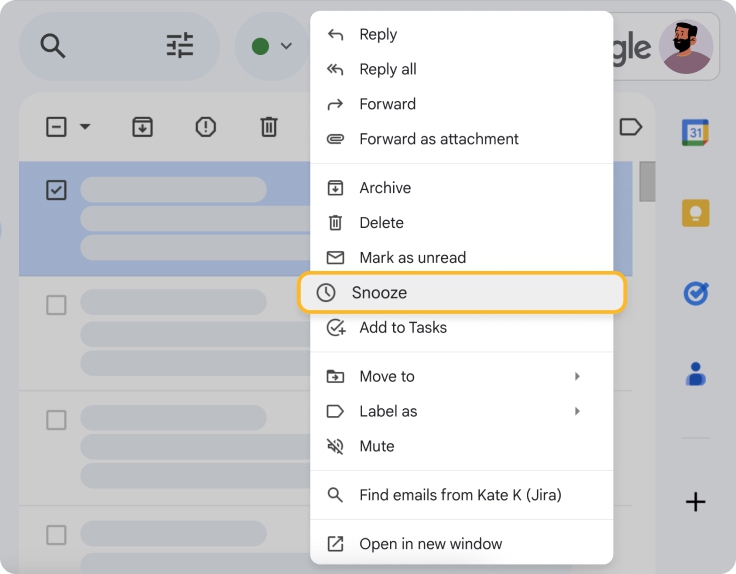
You can find all snoozed messages by opening the main menu (the three horizontal lines to the left of the Gmail logo) and selecting the Snoozed option.
Tip 3: Make Gmail Optimization Part of Your Daily Routine
Gmail optimization takes time, so you should make it part of your daily routine so that you don’t neglect it.
We recommend you set a specific time each day for inbox optimization, preferably before you start your day or after you’re done with work.
Ideally, you want to end your Gmail optimization routine by reaching Inbox Zero, a state when there are no emails in your inbox because you’ve organized everything.
Having a second mail account on Outlook? Follow our guide on how to optimize Outlook inbox.
How to Optimize Gmail - FAQs
How to use Gmail effectively?
To use Gmail effectively, explore advanced features like labels, filters, and the Snooze option to manage emails. Consider implementing Clean Email's tools, such as Auto Clean and Undsubscriber, to automate and optimize inbox organization.
Is Clean Email safe to optimize Gmail with?
Yes, the app is committed to security and privacy, and the app doesn’t keep, sell, or analyze user data for any purposes beyond providing its public features.
How often should I optimize my Gmail?
You should optimize your Gmail as often as necessary to prevent it from becoming messy. Ideally, you should automate your inbox management using the Auto Clean feature of Clean Email app.
How to check how much free memory I have on Gmail?
To check your free storage space in Gmail, scroll to the bottom of your inbox to see a summary of used space. For a detailed view, visit https://drive.google.com/settings/storage.
How to prioritize emails in Gmail?
To prioritize emails in Gmail, you can use the Priority Inbox feature that automatically sorts emails based on importance. Additionally, you can assign them different labels, star them, or mark them as important.


